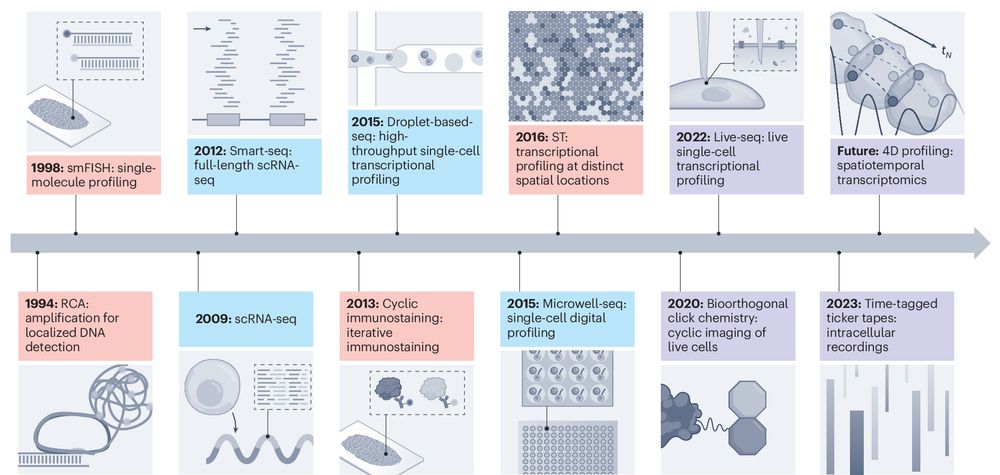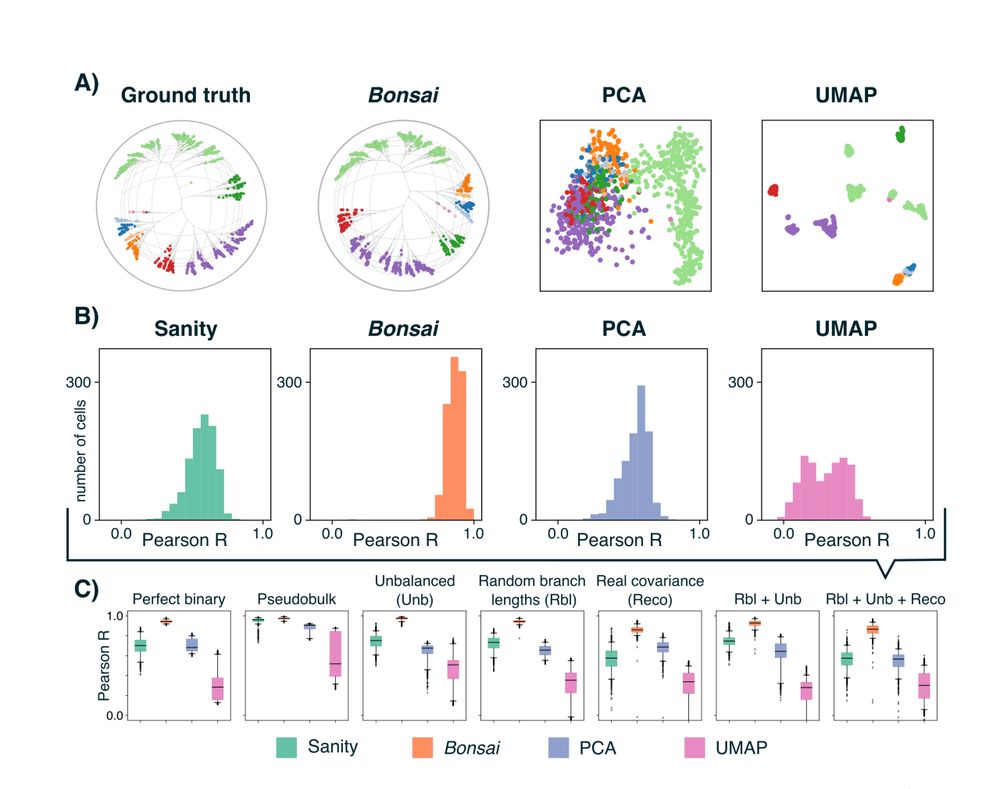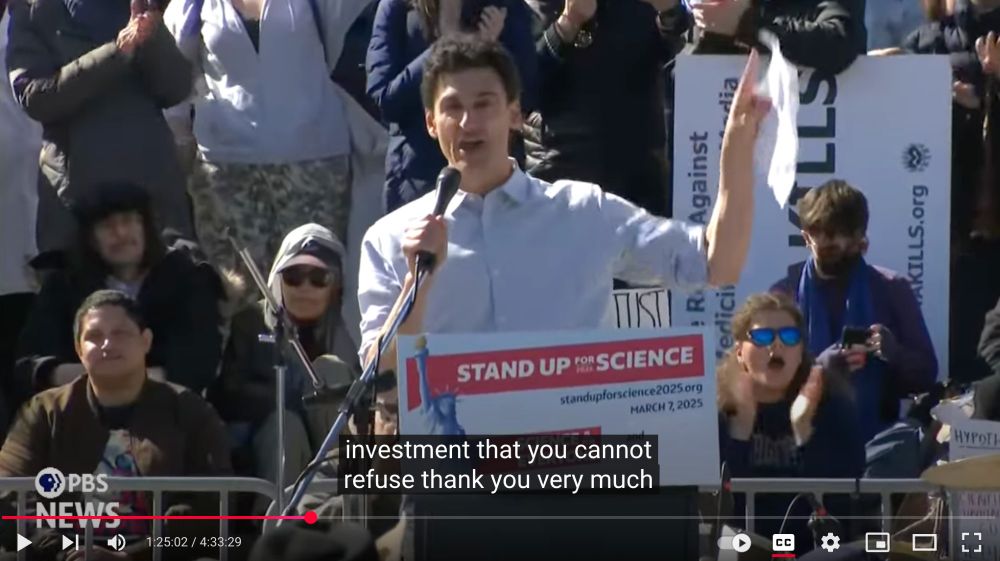Lukas Hatscher
@loggas.bsky.social
MD, PhD candidate in Institute of Computational Biomedicine - AG Schapiro, Interested in quantitative tissue analysis 💻
www.github.com/LukasHats
www.github.com/LukasHats
Reposted by Lukas Hatscher
Introducing Count COMET 🧛🧛♀️
Happy Halloween! 🎃
Happy Halloween! 🎃


October 31, 2025 at 9:35 AM
Introducing Count COMET 🧛🧛♀️
Happy Halloween! 🎃
Happy Halloween! 🎃
Reposted by Lukas Hatscher
Our benchmark + guidelines for atlas-level differential gene expression of single cells is online:
academic.oup.com/bib/article/...
Bottom line: Use pseudobulk + DESeq2 in simple and pseudobulk + DREAM in more complex settings.
Collab w/ @leonhafner.bsky.social @itisalist.bsky.social
academic.oup.com/bib/article/...
Bottom line: Use pseudobulk + DESeq2 in simple and pseudobulk + DREAM in more complex settings.
Collab w/ @leonhafner.bsky.social @itisalist.bsky.social

August 13, 2025 at 5:51 AM
Our benchmark + guidelines for atlas-level differential gene expression of single cells is online:
academic.oup.com/bib/article/...
Bottom line: Use pseudobulk + DESeq2 in simple and pseudobulk + DREAM in more complex settings.
Collab w/ @leonhafner.bsky.social @itisalist.bsky.social
academic.oup.com/bib/article/...
Bottom line: Use pseudobulk + DESeq2 in simple and pseudobulk + DREAM in more complex settings.
Collab w/ @leonhafner.bsky.social @itisalist.bsky.social
This guy really dedicated his life to science:
www.sciencedirect.com/science/arti...
www.science.org/content/arti...
www.sciencedirect.com/science/arti...
www.science.org/content/arti...

Snake venom protection by a cocktail of varespladib and broadly neutralizing human antibodies
Snake envenomation is a neglected tropical disease, with 600 species causing over 100,000 deaths and 300,000 permanent disabilities in humans annually…
www.sciencedirect.com
September 18, 2025 at 6:47 AM
This guy really dedicated his life to science:
www.sciencedirect.com/science/arti...
www.science.org/content/arti...
www.sciencedirect.com/science/arti...
www.science.org/content/arti...
I am excited to share my first work in @schapirolab.bsky.social on Multiple Myeloma (MM) in collaboration with the Standal Lab from NTNU Norway. We use Imaging Mass Cytometry (IMC) on bone marrow biopsies from MM and precursor patients (details below): www.biorxiv.org/content/10.1...

Highly multiplexed imaging recovers immune and metabolic niches in multiple myeloma associated with disease progression and bone involvement
Multiple myeloma (MM) is a cancer arising from genetically aberrant plasma cells (PCs) that remain dependent on the bone marrow (BM) microenvironment for disease establishment and progression. Here, w...
www.biorxiv.org
September 13, 2025 at 8:25 AM
I am excited to share my first work in @schapirolab.bsky.social on Multiple Myeloma (MM) in collaboration with the Standal Lab from NTNU Norway. We use Imaging Mass Cytometry (IMC) on bone marrow biopsies from MM and precursor patients (details below): www.biorxiv.org/content/10.1...
Reposted by Lukas Hatscher
Nature Method: Temporal and spatial omics technologies for 4D profiling
www.nature.com/articles/s4...
www.nature.com/articles/s4...

Temporal and spatial omics technologies for 4D profiling
Nature Methods - This Perspective explores advances and future directions in spatiotemporal omics methods for four-dimensional profiling.
www.nature.com
August 3, 2025 at 2:15 PM
Nature Method: Temporal and spatial omics technologies for 4D profiling
www.nature.com/articles/s4...
www.nature.com/articles/s4...
Reposted by Lukas Hatscher
And for anyone who has considered contributing to an open source package: don't be scared to propose changes.
Even if it's not a complete and perfect solution, whoever is maintaining the package will help you in get to the right solution and they will be incredibly grateful.
Even if it's not a complete and perfect solution, whoever is maintaining the package will help you in get to the right solution and they will be incredibly grateful.
July 15, 2025 at 1:31 PM
And for anyone who has considered contributing to an open source package: don't be scared to propose changes.
Even if it's not a complete and perfect solution, whoever is maintaining the package will help you in get to the right solution and they will be incredibly grateful.
Even if it's not a complete and perfect solution, whoever is maintaining the package will help you in get to the right solution and they will be incredibly grateful.
Reposted by Lukas Hatscher
For people like me who don't have a team behind a package like CellCharter, contributions like these mean a lot. So thank you Lukas :)
And congratulations, it's not always easy to jump into an existing codebase and propose changes.
And congratulations, it's not always easy to jump into an existing codebase and propose changes.
July 15, 2025 at 1:31 PM
For people like me who don't have a team behind a package like CellCharter, contributions like these mean a lot. So thank you Lukas :)
And congratulations, it's not always easy to jump into an existing codebase and propose changes.
And congratulations, it's not always easy to jump into an existing codebase and propose changes.
Reposted by Lukas Hatscher
RCS measures how large a cell niche (aka spatial domain aka spatial cluster) is compared to what would be normally expected.
This pushed me to completely rewrite the system for generating and plotting boundaries for cell niches.
The new system is now more efficient, consistent, and visually clear.
This pushed me to completely rewrite the system for generating and plotting boundaries for cell niches.
The new system is now more efficient, consistent, and visually clear.

July 15, 2025 at 1:31 PM
RCS measures how large a cell niche (aka spatial domain aka spatial cluster) is compared to what would be normally expected.
This pushed me to completely rewrite the system for generating and plotting boundaries for cell niches.
The new system is now more efficient, consistent, and visually clear.
This pushed me to completely rewrite the system for generating and plotting boundaries for cell niches.
The new system is now more efficient, consistent, and visually clear.
Reposted by Lukas Hatscher
A few weeks ago, we released CellCharter v0.3.5.
Among some bug fixes, we received our first contribution from an external contributor: @loggas.bsky.social !
He designed a new metric called Relative Component Size (RCS).
Among some bug fixes, we received our first contribution from an external contributor: @loggas.bsky.social !
He designed a new metric called Relative Component Size (RCS).

GitHub - CSOgroup/cellcharter: A Python package for the identification, characterization and comparison of spatial clusters from spatial -omics data.
A Python package for the identification, characterization and comparison of spatial clusters from spatial -omics data. - CSOgroup/cellcharter
github.com
July 15, 2025 at 1:31 PM
A few weeks ago, we released CellCharter v0.3.5.
Among some bug fixes, we received our first contribution from an external contributor: @loggas.bsky.social !
He designed a new metric called Relative Component Size (RCS).
Among some bug fixes, we received our first contribution from an external contributor: @loggas.bsky.social !
He designed a new metric called Relative Component Size (RCS).
Reposted by Lukas Hatscher
Spotted: @loggas.bsky.social and @arojhada.bsky.social teaching phenotyping to our Advanced Systems Biology students

July 4, 2025 at 7:23 PM
Spotted: @loggas.bsky.social and @arojhada.bsky.social teaching phenotyping to our Advanced Systems Biology students
Reposted by Lukas Hatscher
🖥️🧬 I used to have to tell my students not to bother with differential expression analysis in a language outside of R. Recently, with pydeseq2 and now InMoose, this is changing!
bmcbioinformatics.biomedcentral.com/articles/10....
bmcbioinformatics.biomedcentral.com/articles/10....

Differential expression analysis with inmoose, the integrated multi-omic open-source environment in Python - BMC Bioinformatics
Background Differential gene expression analysis is a prominent technique for the analysis of biomolecular data to identify genetic features associated with phenotypes. Limma—for microarray data –, an...
bmcbioinformatics.biomedcentral.com
June 25, 2025 at 2:39 PM
🖥️🧬 I used to have to tell my students not to bother with differential expression analysis in a language outside of R. Recently, with pydeseq2 and now InMoose, this is changing!
bmcbioinformatics.biomedcentral.com/articles/10....
bmcbioinformatics.biomedcentral.com/articles/10....
Reposted by Lukas Hatscher
Here it is! Bonsai. Now there is really no more excuse for using t-SNE/UMAP. Bonsai not only makes cool pictures of your data. It actually rigorously preserves its structure. No tunable parameters. Incredible work by @dhdegroot.bsky.social.
I'm so excited about this!
www.biorxiv.org/content/10.1...
I'm so excited about this!
www.biorxiv.org/content/10.1...

Bonsai: Tree representations for distortion-free visualization and exploratory analysis of single-cell omics data
Single-cell omics methods promise to revolutionize our understanding of gene regulatory processes during cell differentiation, but analysis of such data continues to pose a major challenge. Apart from...
www.biorxiv.org
May 9, 2025 at 10:49 AM
Here it is! Bonsai. Now there is really no more excuse for using t-SNE/UMAP. Bonsai not only makes cool pictures of your data. It actually rigorously preserves its structure. No tunable parameters. Incredible work by @dhdegroot.bsky.social.
I'm so excited about this!
www.biorxiv.org/content/10.1...
I'm so excited about this!
www.biorxiv.org/content/10.1...
Reposted by Lukas Hatscher
An alternative to tSNE & UMAP for more accurate data visualization:
Tree representations for distortion-free visualization and exploratory analysis of single-cell omics data.
The trees are constructed to accurately represent true distances between the objects in the high-dimensional space.
Tree representations for distortion-free visualization and exploratory analysis of single-cell omics data.
The trees are constructed to accurately represent true distances between the objects in the high-dimensional space.

May 9, 2025 at 11:07 AM
An alternative to tSNE & UMAP for more accurate data visualization:
Tree representations for distortion-free visualization and exploratory analysis of single-cell omics data.
The trees are constructed to accurately represent true distances between the objects in the high-dimensional space.
Tree representations for distortion-free visualization and exploratory analysis of single-cell omics data.
The trees are constructed to accurately represent true distances between the objects in the high-dimensional space.
Reposted by Lukas Hatscher
In addition to the two #SpatialBiology posts in the thread below, we're now also advertising for a Research Software Engineer #RSE to help us take #MuSpAn to the next level - come and join us!
my.corehr.com/pls/uoxrecru...
#academic #jobs #softwaredeveloper #compsci
my.corehr.com/pls/uoxrecru...
#academic #jobs #softwaredeveloper #compsci
May 1, 2025 at 2:15 PM
In addition to the two #SpatialBiology posts in the thread below, we're now also advertising for a Research Software Engineer #RSE to help us take #MuSpAn to the next level - come and join us!
my.corehr.com/pls/uoxrecru...
#academic #jobs #softwaredeveloper #compsci
my.corehr.com/pls/uoxrecru...
#academic #jobs #softwaredeveloper #compsci
Reposted by Lukas Hatscher
And it's finally here! napari 0.6.0 is out on PyPI and conda-forge! 🥳 We've had a few threads about this release already but let's recap with some highlights: 🧵
May 1, 2025 at 2:06 PM
And it's finally here! napari 0.6.0 is out on PyPI and conda-forge! 🥳 We've had a few threads about this release already but let's recap with some highlights: 🧵
Reposted by Lukas Hatscher
Big updates for the Nextflow @vscode.dev extension! 🚀
🔍 Workflow view – Visualize logical structure of pipelines
⚙️ Process view – See all processes in one place
🌐 Seqera view – Manage connected CEs directly in the IDE
📚 Resources view – Quickly access Copilot, AI tools & training
🔍 Workflow view – Visualize logical structure of pipelines
⚙️ Process view – See all processes in one place
🌐 Seqera view – Manage connected CEs directly in the IDE
📚 Resources view – Quickly access Copilot, AI tools & training
April 17, 2025 at 1:36 PM
Big updates for the Nextflow @vscode.dev extension! 🚀
🔍 Workflow view – Visualize logical structure of pipelines
⚙️ Process view – See all processes in one place
🌐 Seqera view – Manage connected CEs directly in the IDE
📚 Resources view – Quickly access Copilot, AI tools & training
🔍 Workflow view – Visualize logical structure of pipelines
⚙️ Process view – See all processes in one place
🌐 Seqera view – Manage connected CEs directly in the IDE
📚 Resources view – Quickly access Copilot, AI tools & training
Reposted by Lukas Hatscher
Miso made in space tastes nuttier!
Researchers successfully make miso at the #InternationalSpaceStation, confirming that making fermented foods in space is possible. www.cell.com/iscience/ful...
@medialab.bsky.social Maggie Coblentz
@novo-nordisk.bsky.social Joshua D. Evans
@cp-cell.bsky.social
Researchers successfully make miso at the #InternationalSpaceStation, confirming that making fermented foods in space is possible. www.cell.com/iscience/ful...
@medialab.bsky.social Maggie Coblentz
@novo-nordisk.bsky.social Joshua D. Evans
@cp-cell.bsky.social



April 2, 2025 at 8:12 PM
Miso made in space tastes nuttier!
Researchers successfully make miso at the #InternationalSpaceStation, confirming that making fermented foods in space is possible. www.cell.com/iscience/ful...
@medialab.bsky.social Maggie Coblentz
@novo-nordisk.bsky.social Joshua D. Evans
@cp-cell.bsky.social
Researchers successfully make miso at the #InternationalSpaceStation, confirming that making fermented foods in space is possible. www.cell.com/iscience/ful...
@medialab.bsky.social Maggie Coblentz
@novo-nordisk.bsky.social Joshua D. Evans
@cp-cell.bsky.social
Reposted by Lukas Hatscher
Super excited to finally see this published! Our new method to use combinatorial staining and deep learning to push the multiplexing boundaries of spatial proteomics!
High-dimensional imaging using combinatorial channel multiplexing and deep learning go.nature.com/4hGPfO0

High-dimensional imaging using combinatorial channel multiplexing and deep learning - Nature Biotechnology
Protein imaging is multiplexed using combinatorial staining and deep learning decompression.
go.nature.com
March 26, 2025 at 4:12 AM
Super excited to finally see this published! Our new method to use combinatorial staining and deep learning to push the multiplexing boundaries of spatial proteomics!
Reposted by Lukas Hatscher
Science is an investment that pays enormous dividends. So if you’re business-minded, it’s an offer you can’t refuse!
Here's my full speech from the Stand Up For Science rally in DC today: www.youtube.com/watch?v=eemj...
Here's my full speech from the Stand Up For Science rally in DC today: www.youtube.com/watch?v=eemj...

March 7, 2025 at 11:01 PM
Science is an investment that pays enormous dividends. So if you’re business-minded, it’s an offer you can’t refuse!
Here's my full speech from the Stand Up For Science rally in DC today: www.youtube.com/watch?v=eemj...
Here's my full speech from the Stand Up For Science rally in DC today: www.youtube.com/watch?v=eemj...
Reposted by Lukas Hatscher
🧵 We are excited to share our new paper, showcasing micronuclAI, which leverages #AI and #ComputerVision to detect #chromosomal_instability #CIN #micronuclei
Congratulations to @miguelib.bsky.social and Lindsay Caprio for leading this project.
Congratulations to @miguelib.bsky.social and Lindsay Caprio for leading this project.
March 7, 2025 at 3:48 PM
🧵 We are excited to share our new paper, showcasing micronuclAI, which leverages #AI and #ComputerVision to detect #chromosomal_instability #CIN #micronuclei
Congratulations to @miguelib.bsky.social and Lindsay Caprio for leading this project.
Congratulations to @miguelib.bsky.social and Lindsay Caprio for leading this project.
Reposted by Lukas Hatscher
The March issue is out! This week: TOX-inducible-KO 🐁show how #TOX maintains #exhausted CD8 #Tcell epigenetic fate; visualizing temporal & spatial #STING expression; & UVB-driven #mitochondrial Z-🧬complexed w ZBP1 fuels #autoimmune #photosensitivity via cGAS-STING!
science.org/toc/sciimmunol/10/105
science.org/toc/sciimmunol/10/105

March 7, 2025 at 8:07 PM
The March issue is out! This week: TOX-inducible-KO 🐁show how #TOX maintains #exhausted CD8 #Tcell epigenetic fate; visualizing temporal & spatial #STING expression; & UVB-driven #mitochondrial Z-🧬complexed w ZBP1 fuels #autoimmune #photosensitivity via cGAS-STING!
science.org/toc/sciimmunol/10/105
science.org/toc/sciimmunol/10/105
Reposted by Lukas Hatscher
In an unprecedented move, the US National Institutes of Health has begun mass terminations of research grants that fund active scientific projects because they no longer meet “agency priorities”.
https://go.nature.com/4bpG2It
https://go.nature.com/4bpG2It

Exclusive: NIH to terminate hundreds of active research grants
Studies that touch on LGBT+ health, gender identity and DEI in the biomedical workforce could be terminated, according to documents obtained by Nature.
go.nature.com
March 6, 2025 at 2:25 AM
In an unprecedented move, the US National Institutes of Health has begun mass terminations of research grants that fund active scientific projects because they no longer meet “agency priorities”.
https://go.nature.com/4bpG2It
https://go.nature.com/4bpG2It
Reposted by Lukas Hatscher
One week to go!
Are you a postdoc at @uniheidelberg.bsky.social? Don't forget to sign up!

Kick off networking event (free)
Mar 13, 2025 at 5:00 PM – 8:00 PM
heidelbergunipostd.wixsite.com
March 6, 2025 at 10:10 AM
One week to go!
Does anyone have a good universal membrane marker besides NaKATPase and CD98, that ideally stains epithelium/cancer similarly strong as stroma/immune cells? Antibody will be used for spatial proteomics (cyclic IF), goal is a good whole cell segmentation downstream
February 27, 2025 at 2:30 PM
Does anyone have a good universal membrane marker besides NaKATPase and CD98, that ideally stains epithelium/cancer similarly strong as stroma/immune cells? Antibody will be used for spatial proteomics (cyclic IF), goal is a good whole cell segmentation downstream
Reposted by Lukas Hatscher
Gemini Code Assist now free: blog.google/technology/d...
VSCode: marketplace.visualstudio.com/items?itemNa...
Positron: open-vsx.org/extension/Go... #Rstats
VSCode: marketplace.visualstudio.com/items?itemNa...
Positron: open-vsx.org/extension/Go... #Rstats
February 27, 2025 at 10:19 AM
Gemini Code Assist now free: blog.google/technology/d...
VSCode: marketplace.visualstudio.com/items?itemNa...
Positron: open-vsx.org/extension/Go... #Rstats
VSCode: marketplace.visualstudio.com/items?itemNa...
Positron: open-vsx.org/extension/Go... #Rstats

